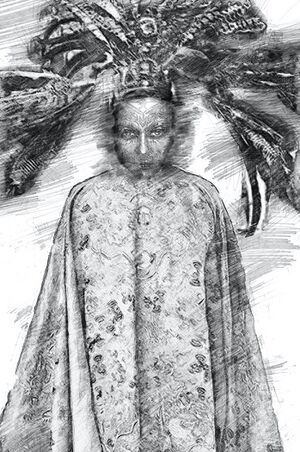Ratukunti
In Hindia Belandan myth, the Ratukunti is a demon whose origins lie in prehistoric Hindia Belandan cultures. The Ratukunti is said to be the leader of the boentianaks, who are vengeful vampiric beings transformed from the spirits of women who died during childbirth. Whilst the boentianaks were human, the Ratukunti is not but only takes on a human form when making an apparition in order to lure unsuspecting people who may be wandering alone on certain nights of the year. When taking a human form, the Ratukunti is described as a lady with facial tattoos, suggesting Austronesian origins, wearing a long robe often associated with the Andjanian nobility and an elaborate headgear with palm fronds. The prevalence of the Ratukunti in virtually every folklore of all islands in Hindia Belanda except the island of Papoea suggests that it was spread by Andjanians during the expansionist period of the Andjani Empire.[1]
Origins
Hindia Belandan folklore features a strong undercurrent of animistic beliefs revolving around nature worship, including the belief that the environment in which humans live are concurrently populated with different kinds of spirits. These beliefs have their origins in the prehistoric and early historical Hindia Belanda, when Austronesian societies began to emerge across the archipelago along with a nascent belief system surrounding the power of nature as manifested in these spirits. Austronesians believed that the actions of these spirits are connected with natural phenomena and commensurate with human actions toward nature itself, thus a spirit is neither inherently malevolent or benevolent. It was only in the early 11th-century that these spirits began to be associated with either goodness and evil. The Ratukunti, once a spirit believed by the early Austronesians to be responsible for the falling of the night, became associated with evil during the expansionist period of the Andjani Empire, when most of the islands in the archipelago fell under Andjanian rule.
It has been hypothesised that the sudden change in the Ratukunti's role was intentional in order to transform the myth into a social engineering tool to discourage people from travelling alone at night and thus becoming targets of criminals and wild animals alike.
Appearance and characteristics
The colonial-era anthropologist Emma K. de Vries wrote about the Ratukunti as described to her by a village chief in her 1913 seminal work Boekoe Hikajat Hantoe Hindia-Belanda, detailing Hindia Belandan supernatural entities.
During the five days that I remained in the village of Poe'oen Terbang, in the Regentschap Kelawi on the island of Somatra, I happened upon the village chief, named Abdorahman, whom I enquired regarding the nature of the Ratukunti. Hesitant at first – and understandably so as even the utterance of her name is said to bring a series of misfortunes – the village chief agreed to describe the Ratukunti to me as we sat on his veranda. A Sunni Mohammedan, as are most inhabitants of this village, Abdorahman began by reciting a prayer in Riysan to ward off evil. He then gargled with some water infused with pandan and spat onto the ground in front of us. This markedly Animist ritual, I later learnt, is one of several ways one can protect oneself from the Ratukunti.
Abdorahman then told me that the Ratukunti is not human, but rather a demon whose origins is not of this earth. A cunning and evil being, the Ratukunti is able to transform into human form on certain nights of the year, donning the robe of ancient Andjanian nobility and a palm fronds headgear, to lure an unsuspecting person who may be wandering alone at night. Once she finds a victim, she uses her sharp, long nails to stab their heart and thereupon her gruesome feast may begin. If she is interrupted during her feast by multiple people, the Ratukunti will fly away, leaving the body of her victim. But if interrupted by another unsuspecting and solitary person, she will do unto that person that which she has done to her other victim. Abdorahman then told me that it is not safe to talk about the Ratukunti on certain nights of the year in the Javanese calendar: the first night of the second month; the second night of the eighth month; and the twentieth night of the tenth month, the last of which is known as the 'Night of the Great Kunti', the most supernaturally dangerous of all nights. [2]
Night of the Great Kunti
Pre-1900s observance
Modern day observance
Regional variations
Notable apparitions
Pulu Teh, 1912
North Batavia, 1918
Jakarta, 1933
As cultural icon
Notes
References
- Ladjoeng, Hartono (2007). "Some Reflections on the Societal Purposes of Hindia Belandan folk beliefs", The Hindia Belandan Journal of Anthropology
